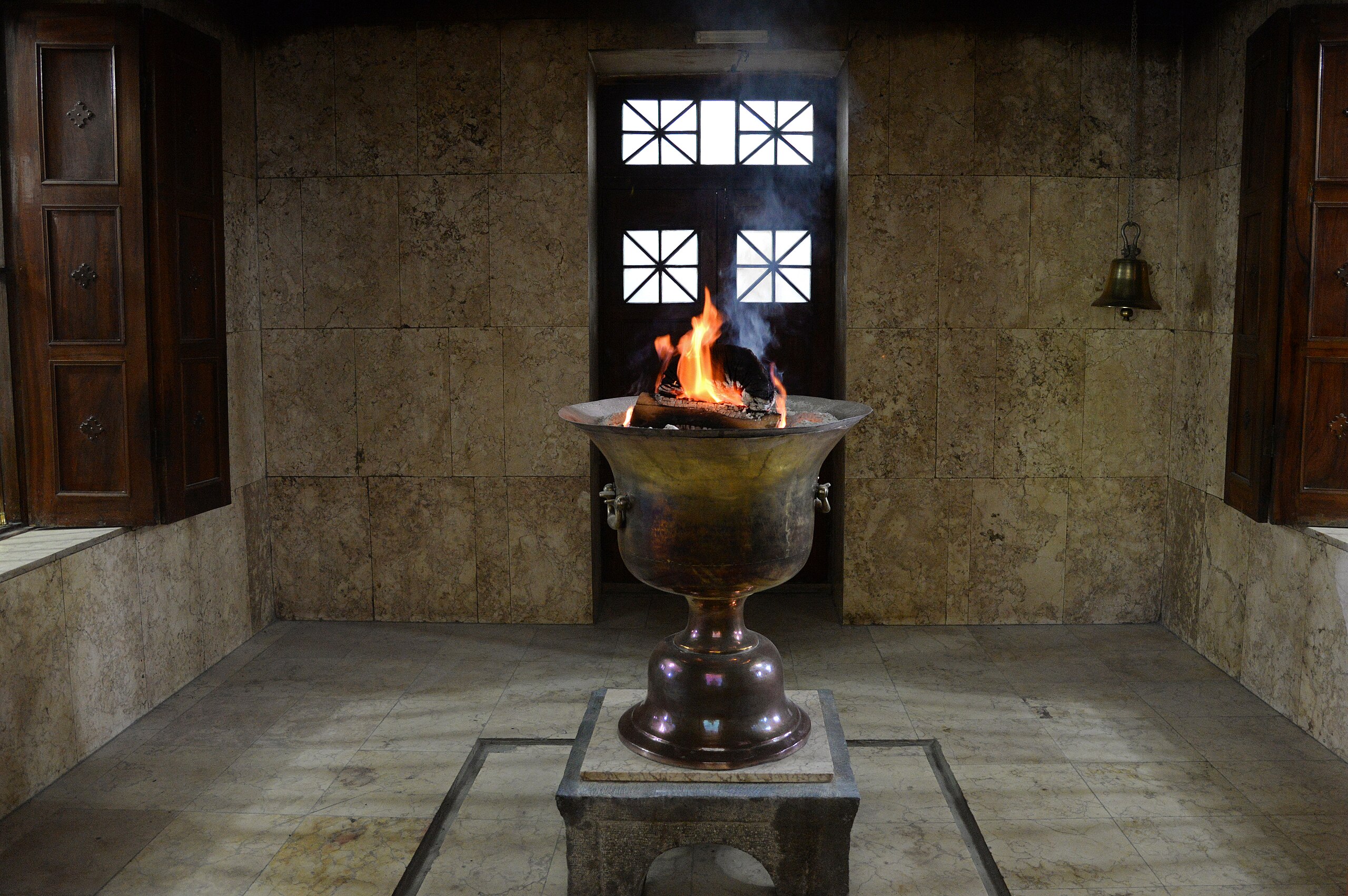| Sassanid Persia
By Mike Bennighof, Ph.D.
December 2024
 Late Rome’s and early Byzantium’s greatest enemy,
the Sassanid dynasty of Persia, entered the history books
in 226 A.D., when a Persian vassal-king named Ardashir revolted
against the Parthian rulers of Persia. The Parthians, a Central
Asian warrior people, had in turn overthrown the Greek Seleucid
rulers in 6 B.C. Late Rome’s and early Byzantium’s greatest enemy,
the Sassanid dynasty of Persia, entered the history books
in 226 A.D., when a Persian vassal-king named Ardashir revolted
against the Parthian rulers of Persia. The Parthians, a Central
Asian warrior people, had in turn overthrown the Greek Seleucid
rulers in 6 B.C.
Ardashir had already greatly expanded his kingdom of Estakhr
in what today is southwestern Iran. He twice defeated Artabanus
V, the last Parthian king, and arranged a final, formal challenge
for control of the empire on an open, rocky plain near Hormuz.
According to legend, Ardashir rode out and challenged Artabanus
to single combat, then turned his horse and feigned a panicked
flight. When Artabanus followed, Ardashir slowed his horse
and turned to loose an arrow in the ironically named “Parthian
shot.” The arrow took the Parthian ruler in the heart
and he slid from the saddle already dead. The Persians then
routed the Parthian army, and Ardashir (sometimes styled Artaxerxes)
became undisputed ruler of Persian lands.
  
Ardashir named his dynasty after his grandfather, Sassan,
a noted magus or Zoroastrian priest. Zoroastrianism, one of
the oldest monothesitic faiths, had been associated with the
old Achamaenid dynasty overthrown by Alexander the Great and
been widespread among the Persians for over a thousand years.
Under the new dynasty, Zoroastrianism became the state religion.
The faith was codified and standardized, and became more centered
on rituals than previously. The Sassanids encouraged that
previously oral traditions be written down and preserved.
Fire temples became a standard feature of every Persian city,
with the greatest of them in the Sassanid capital of Ctesiphon.

Ahura
Mazda, Zoroastrian deity.
The early Parthian kings had adopted many ways of the preceding
Seleucid Greek dyansty, but by their last decades Zoroastrianism
was already reviving and Artabanus himself may have been a
believer. The spiritual revival of Zoroastrianism coincided
with the rise of Christianity just to the west, and the two
vibrant faiths clashed in the mountains of eastern Anatolia.
Armenia had followed Zoroaster’s faith in earlier times,
and now the Sassanids hoped to bring it back into the fold.
But Christianity also was gaining a firm following among the
Armenians. Rome and Persia fought almost immediately after
Ardashir’s seizure of power, when the Sassanids invaded
Roman Mesopotamia and were briefly repulsed by Alexander Severus
before seizing several key cities.
Shapur I followed his father Ardashir in 242, and inherited
the ongoing wars with Rome. The Roman Emperor Gordian attempted
to re-take Mesopotamia, and after winning several battles
was murdered. The Persians defeated his successor, Philip
the Arab, and forced him to pay ransom and abandon Roman support
for Armenia. Sassanid attempts to conquer the mountain kingdom
led to new war with Rome in 253. Shapur defeated and captured
the Emperor Valerian, killing or capturing 70,000 Romans at
the Battle of Edessa. According to legend, he used the Roman
leader as a human mounting block, making him kneel before
Shapur’s horse so the king of kings could step on his
back. This part may be true, but the legend that Shapur had
Valerian’s corpse tanned and stuffed is probably not.

A fire temple, where good thoughts, words and deeds are praised.
Rome’s ally Palmyra now took a hand, and its prince
Odenathus recaptured Roman Mesopotamia. Such success could
not go unpunished; the prince’s wife, the lovely Zenobia,
had him killed and took power herself. Rome crushed her desert
kingdom in retribution.
After some years of peace on the western front, marked by
many Persian campaigns in what today is Afghanistan and Pakistan,
the Roman Emperor Carus invaded and captured Ctesiphon. At
the peak of his success, he mysteriously died (the fate of
several Roman rulers who fought the Sassanids) and the Persians
recovered their capital. They fought Rome again in 297, suffering
several defeats and losing most of their territories west
of the Tigris River. The subsequent peace lasted 40 years,
however, setting the stage for Persian Front.
At the time of the battles depicted in Persian Front, Shapur
II sat the throne as King of Kings. His father having died
before Shapur’s birth, Shapur II enjoyed the distinction
of being “born a king” and made much of this circumstance
to echo the virgin birth of Zoroaster himself. With a baby
on the throne, both the Zoroastrian clergy and the powerful
landowning class greatly expanded their power. Yet by age
15, Shapur II had reclaimed his absolute authority and brought
both to heel.
The peace with Rome allowed Shapur to consolidate power and
prepare for a new struggle, which became inevitable in 313
when Constantine legalized Christianity in Rome and converted.
Christianity had attracted a number of Persian converts; its
similarity to Zoroastrianism made it easy to understand, and
many found its personal nature highly attractive. But once
it started down the road to becoming Rome’s state religion,
Shapur considered anyone following it to be committing treason
against the throne. In 339 he declared the followers of Christ
to be criminals, and also cracked down on Jews and Manicheans
(followers of Mani, a magus who tried to fuse the three faiths).
Shapur struck first, invading Roman Mesopotamia in 340 and
winning some field battles but failing to take the great fortress-city
of Nisibis. In 350 he made peace with Rome to go fight an
invasion of the Huns, who he defeated and forced into an alliance
in 357. With his eastern borders secure, he returned to war
with Rome, leading to the battles shown in Fading Legions.
  
The Sassanid army led by Shapur II, like those of his predecessors
and the later Parthians, was built around cataphract cavalry.
These were heavily armored horses and riders, relying on shock
action with lances. Elephants, obtained from India, also featured
in the Persian order of battle, and usually large numbers
of tribal light cavalry. Persian armies usually brought a
great deal of infantry levies with them to pin an enemy army
in place, but relied on the heavy horse for the decisive blow.
Mounted bowmen, a response to Shapur’s war with the
Huns, were just starting to appear in larger numbers.
After his defeat of the Romans, Shapur (now known as The Great)
regained all the territories lost in the previous century,
plus a free hand to deal with Armenia. But his successors
would be much weaker men, and Persia remained weak until the
great king of kings Chosroes I Anashirvan in 531. But that’s
another story and, eventually, another game.
Click here to join the Gold Club.
See your Gold Club Insider newsletter for ordering information.
Sign up for our newsletter right here. Your info will never be sold or transferred; we'll just use it to update you on new games and new offers.
Mike Bennighof is president of Avalanche Press and holds a doctorate in history from Emory University. A Fulbright Scholar and NASA Journalist in Space finalist, he has published a great many books, games and articles on historical subjects; people are saying that some of them are actually good.
He lives in Birmingham, Alabama with his wife, three children, and new puppy. He misses his lizard-hunting Iron Dog, Leopold.
Daily Content includes no AI-generated content or third-party ads. We work hard to keep it that way, and that’s a lot of work. You can help us keep things that way with your gift through this link right here.
|
